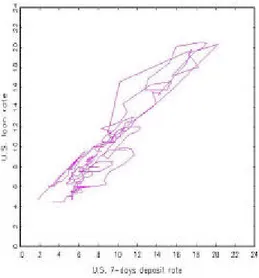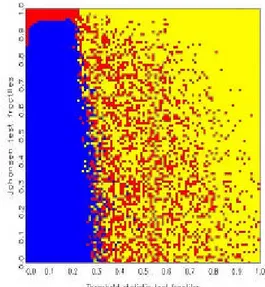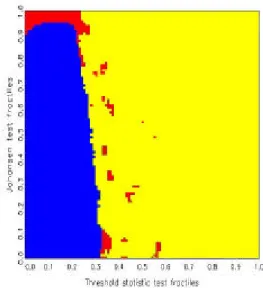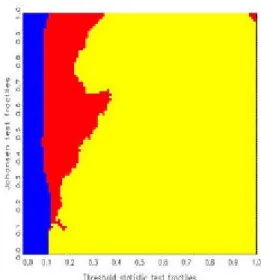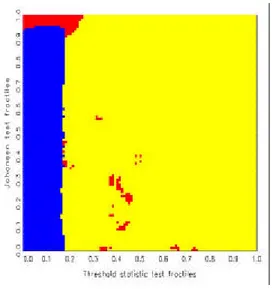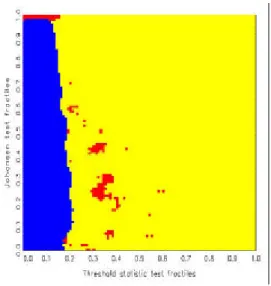IHS Economics Series Working Paper 121
September 2002
Decision Maps for Bivariate Time Series with Potential Threshold Cointegration
Robert M. Kunst
Impressum Author(s):
Robert M. Kunst Title:
Decision Maps for Bivariate Time Series with Potential Threshold Cointegration ISSN: Unspecified
2002 Institut für Höhere Studien - Institute for Advanced Studies (IHS) Josefstädter Straße 39, A-1080 Wien
E-Mail: o ce@ihs.ac.atffi Web: ww w .ihs.ac. a t
All IHS Working Papers are available online: http://irihs. ihs. ac.at/view/ihs_series/
Decision Maps for Bivariate Time Series with Potential Threshold Cointegration
Robert M. Kunst
121
Reihe Ökonomie
Economics Series
121 Reihe Ökonomie Economics Series
Decision Maps for Bivariate Time Series with Potential Threshold Cointegration
Robert M. Kunst
September 2002
Contact:
Robert M. Kunst University of Vienna and
Institute for Advanced Studies Department of Economics
Stumpergasse 56, A-1060 Vienna, Austria (: +43/1/599 91-255
email: kunst@ihs.ac.at
Founded in 1963 by two prominent Austrians living in exile – the sociologist Paul F. Lazarsfeld and the economist Oskar Morgenstern – with the financial support from the Ford Foundation, the Austrian Federal Ministry of Education and the City of Vienna, the Institute for Advanced Studies (IHS) is the first institution for postgraduate education and research in economics and the social sciences in Austria.
The Economics Series presents research done at the Department of Economics and Finance and aims to share “work in progress” in a timely way before formal publication. As usual, authors bear full responsibility for the content of their contributions.
Das Institut für Höhere Studien (IHS) wurde im Jahr 1963 von zwei prominenten Exilösterreichern – dem Soziologen Paul F. Lazarsfeld und dem Ökonomen Oskar Morgenstern – mit Hilfe der Ford- Stiftung, des Österreichischen Bundesministeriums für Unterricht und der Stadt Wien gegründet und ist somit die erste nachuniversitäre Lehr- und Forschungsstätte für die Sozial- und Wirtschafts - wissenschaften in Österreich. Die Reihe Ökonomie bietet Einblick in die Forschungsarbeit der Abteilung für Ökonomie und Finanzwirtschaft und verfolgt das Ziel, abteilungsinterne Diskussionsbeiträge einer breiteren fachinternen Öffentlichkeit zugänglich zu machen. Die inhaltliche
Abstract
Bivariate time series data often show strong relationships between the two components, while both individual variables can be approximated by random walks in the short run and are obviously bounded in the long run. Three model classes are considered for a time-series model selection problem: stable vector autoregressions, cointegrated models, and globally stable threshold models. It is demonstrated how simulated decision maps help in classifying observed time series. The maps process the joint evidence of two test statistics: a canonical root and an LR--type specification statistic for threshold effects.
Keywords
Model selection, Bayes testing, nonlinear time series models
JEL Classifications
C11, C15, C32
Comments
The data on U.S. interest rates are taken from the International Financial Statistics database. The
Contents
1 Introduction 1
2 Designing the simulation 4
2.1 Decision maps ...4
2.2 The model hypotheses ...6
2.3 The discriminatory statistics... 10
2.4 Smoothing ... 11
3 Simulation results: the maps 12
4 Summary and conclusion 21
Appendix:
Geometric ergodicity of threshold cointegrated models 23
References 25
1 Introduction
Bivariate time series data often exhibit features like the pair of retail interest rates in Figure 1. The two component series appear to be closely linked such that deviations from each other are relatively small. For long time spans, the variables move up or down the positive diagonal, with very little memory with respect to this motion. Individually, the series appear to be well described as random walks or at least as …rst-order integrated processes with low autocorrelation in the di¤erences. Eventually, however, the upward or downward motion seemingly hits upon some outer boundary and is reversed, such that all observations are contained in a bounded interval, in the long run. The bounds of the interval are assumed as unknown. A good example for such pairs of time series data are interest rates, such as saving and loan rates or bill and bond rates, though a deep economic analysis of interest rates is outside the scope of this paper. We just observe that they attain their maximum in phases of high in‡ation and that their minimum is usually strictly positive.
Figure 1: Time-series scatter plot of monthly data on U.S. interest rates on loans and 7-days deposits, 1963–2002.
This paper is concerned with selecting an appropriate time series model
for data such as the depicted series, if the set of available classes is given by
the three following ideas. Firstly, the observed reversion to some distribu- tional center may suggest a linear stable vector autoregression. This model class has the drawback that the autoregression is unable to re‡ect the random movement in the short run. Secondly, this movement and the obvious link between the components may suggest a cointegrated vector autoregression.
Particularly for interest rates of di¤erent maturity, this is an idea that ap- pears in the econometric literature, see for example Campbell and Shiller (1987), Hall et al. (1992), or Johansen and Juselius (1992). Enders and Siklos (2001) even state that “it is generally agreed that interest-rate series are I(1) variables that should be cointegrated”. The drawback of this model class is that it is unable to match the long-run boundedness condi- tion. The model contains a unit root, is non-ergodic and inappropriate from a longer-run perspective (see Weidmann, 1999, for a similar argument in economics). Thirdly, one may consider a mixture of the two models, with cointegration prevailing in a ‘normal’ regime and global mean reversion in an ‘outer’ regime. This idea yields a threshold cointegration speci…cation, as it was used by Jumah and Kunst (2002), again for interest rates. The drawback of the model is that it is nonlinear and that it contains some poorly identi…ed parameters.
The concept of threshold cointegration is due to Balke and Fomby (1997, henceforth BF) who assumed a version with cointegration in the outer regime and an integrated process without cointegration in an inner regime.
Jumah and Kunst (2002) suggested a modi…cation of BF’s model that
is in focus here. Threshold cointegration models were also considered by
Enders and Granger (1998), Enders and Falk (1998), and Enders
and Siklos (2001). These contributions focus on asymmetric adjustment
to disequilibrium and hence they mainly use two-regime or single-threshold
models. Hansen and Seo (2002) analyze hypothesis testing for single-
threshold cointegration models and assume cointegration in both regimes,
though with di¤erent cointegrating vectors. Like BF, Lo and Zivot (2001)
consider the case of three regimes, with cointegration in the lower and upper
regimes and no cointegration in the central regime. While these authors allow
for asymmetric reaction or di¤erent cointegrating structures across regimes,
only symmetric reaction outside the band will be considered here, due to
the limited information that is provided by the few observations in the outer
region of our models. Weidmann (1999) analyzed bivariate time series of
an in‡ation index and an interest rates and suggested a three-regimes model
that is close to the one used here. Whereas his model assumes di¤erent
cointegration structures across regimes and achieves global stability by the choice of cointegrating vectors in the outer regimes, we impose local stability in the outer regimes. Tsay (1998) considered related models in a more general framework. His example of ‡ow data for two Icelandic rivers may also conform to the pattern of Figure 1, as the ‡ow is bounded from below by zero and from above by some natural maximum.
Threshold cointegration models are particular threshold vector autore- gressions of the SETAR (self-exciting threshold autoregression) type that was considered by Chan et al. (1985), Tong (1990), Chan (1993), and Chan and Tsay (1998). Particularly Chan et al. (1985) found that stability in the outer regimes is su¢cient, though not necessary, for global stability and geometric ergodicity. It follows that the models suggested here are globally stable and geometrically ergodic. To the author’s knowledge, the proof of this important property has not been given explicitly in the literature. It has been added to this paper as an appendix.
Each of the three outlined model classes deserves attention as a possi- ble data-generating mechanism. It is therefore interesting to study methods that allow selecting among the classes on the basis of observed data. The decision set consists of three elements: the stable vector autoregression, the linear cointegration model, and the threshold cointegration model. Candi- dates for discriminatory statistics are likelihood ratios for any two of these model classes or approximations thereof. The theory of likelihood ratios be- tween the …rst and the second class has been developed by Johansen (1988), hence it is convenient to include this ratio in the vector statistic. As another statistic, we add an approximation to the likelihood ratio of the …rst and the third class.
Model selection is a …nite-action problem and requires procedures beyond
the dichotomy of the standard Neyman-Pearson framework of null and alter-
native hypotheses. Here, the three competing model classes are modeled as
three alternative Bayes data measures. Each measure can be conditioned on
the values of a vector statistic, such that the probability for each hypothesis
can be evaluated conditional on the given or observed test statistic. The
model or hypothesis with maximum probability is then the suggested choice
for the observed value of the statistic. In the space of null fractiles of the test
statistics, one obtains ‘decision maps’ that show distinct regions of preference
for each model class. This approach builds on a suggestion by Hatanaka
(1996) and was used by Kunst and Reutter (2002), among others. For
the present problem, non-informative prior distributions are elicited on the
basis of Jordan distributions (see also Kunst, 2002). Discrete uniform priors over the three hypotheses are allotted implicitly. All calculations of decision maps have been conducted by means of simulation. Decision maps are par- ticularly well suited for model selection based on the joint evaluation of two test statistics.
The remainder of this paper is structured as follows. Section 2 explains the decision maps approach and details the properties of the entertained models, including the elicitation of non-informative prior distributions. Sec- tion 3 reports the simulation results, including the maps and their tentative interpretation. Section 4 concludes.
2 Designing the simulation
2.1 Decision maps
The decision maps approach can be applied to all parameterized problems (f
µ; µ 2 £) for …nite-dimensional £, where a decision is searched among a
…nite number of rival hypotheses (a partition of £), preferably on the basis of a bivariate vector statistic. For a univariate statistic, the maps collapse to intervals on the real line. For vector statistics with a higher dimension, the visual representation of the maps encounters technical di¢culties.
Assume a decision concerns the indexed set of hypotheses f H
j= f µ 2 £
jg , j = 1; : : : ; h g . Usually, model selection utilizes h ¡ 1 likelihood-ratio statistics S
1(j);2(j)or approximations thereof, for ‘null’ hypothesis H
1(j)and alternative H
2(j), with 1 · j < h, 1(j) 6 = 2(j), and 1(j), 2(j ) 2 f 1; : : : ; h g . For ease of notation, let these statistics be collected in an h ¡ 1–dimensional vector sta- tistic S = (S
1; : : : ; S
h¡1)
0, such that S
jand S
1(j)2(j)can be used equivalently.
The classical approach requires nested hypotheses, such that £
1(j)½ £ ¹
2(j), where bars denote topological closure. If parameter sets can be completely ordered, one may write £
j½ £ ¹
j+1for 1 · j < h. Then, two typical choices of vector likelihood-ratio statistics are S = (S
1;2; S
2;3; : : : S
h¡1;h)
0and S = (S
1;h; S
2;h; : : : ; S
h¡1;h)
0.
Let weighting prior distributions be de…ned on each £
j, 1 · j · h by their densities ¼
j. For any pair (1(j ); 2(j)), 1 · j < h, the collection of distributions ¡
f
µ; µ 2 £
1(j)¢ de…nes a null distribution f
1(j)of the statistic S
jvia the implied p.d.f. of this statistic under µ, denoted as f
j;µby Z
£j1
f
j;µ(x)¼
j(µ)dµ = f
1(j)(x) : (1) Note that it is equally possible to de…ne a null distribution f
2(j)of the very same statistic. Let F
1(j)denote the c.d.f. that corresponds to f
1(j). Then, the preference area for £
jis de…ned by
P A
j= f z = (z
1; : : : ; z
h¡1)
02 (0; 1)
h¡1j j = arg max
j
P (H
jj S ) ;
z
k= F
1(k)(S
k) g : (2)
The transformation F
1(k)serves to represent the preference areas conveniently in a simplex instead of some possibly unbounded subspace of R
h¡1. A graph- ical representation of preference areas is called a decision map.
The meaning of (2) can be highlighted by considering its counterpart in classical statistics. Suppose h = 3, and two statistics are evaluated. In a (0; 1)
2–diagram for the fractiles of the null distributions for S
12and S
23, a given sample of observations de…nes a point of realized statistics. Classical statistics would base its decision on rejections in a test sequence, for example starting from the more general decision on S
23. If one-sided tests are used that reject for the upper tails of their null distributions, the classical preference area for hypothesis £
3or H
3is the rectangle A
3= (0; 1) £ (0:95; 1). If £
2is not rejected, test S
12will be applied and separates the preference areas for
£
1, A
1= (0; 0:95) £ (0; 0:95), and for £
2, A
2= (0:95; 1) £ (0; 0:95). Classical statistics may face di¢culties in uniquely determining the null distributions, as fractiles usually vary within each collection. The (0; 1)
2–chart split into the three rectangles constitutes a classical decision map.
Bayesian decision maps are more complex than classical decision maps, as the boundaries among the preference areas may be general curves. Excepting few simple decision problems, it is di¢cult to calculate the value of a condi- tional probability for a given point of the (0; 1)
2–square in the fractile space.
It is more manageable to generate, by numerical simulation, a large number of statistics from the priors with uniform weights across the hypotheses and to collect the observed statistics in a bivariate grid over the fractile space.
Within each ‘bin’, the maximum of the observed values can be evaluated
easily. In computer time, the simulation can be time-consuming but requires
little more storage than hg
2, where h is the number of considered hypotheses
and g is the inverse resolution of the grid, i.e., there are g
2bins.
In summary, numerical calculation of a decision map consists of the fol- lowing steps: …rst, a conveniently large number of replications for each of the two statistics under their respective null distributions are generated; sec- ond, a grid of fractiles are calculated from the sorted simulated data; third, both statistics are generated from any of the competing hypotheses, i.e., from the prior distributions ¼
j. These statistics are allotted into the bins as de-
…ned by the fractiles grid. Finally, each bin is marked as ‘belonging’ to that hypothesis from which it has collected the maximum number of entries.
The simulation of the null fractiles requires a number of replications that is large enough to ensure a useful precision of the fractiles. For the purpose of the graphical map, a high precision may not be required. If the map is intended for usage in later applications, it may also be convenient to replace the exact null distribution by an approximation, particularly if that approx- imation is a standard distribution that allows an evaluation in a closed form.
If the null fractiles indeed have to be simulated, a large number of replica- tions slows down the simulation considerably due to the sorting algorithm that is applied in order to determine empirical fractiles.
By contrast, a fairly large number of replications can be attained for the simulation of statistics conditional on the respective hypotheses. Computer time is limited by the calculation time of the statistics only, which may take time if some iteration or non-linear estimation is required, while only a g £ g matrix of bins for each hypothesis is stored during the simulation. For g = 100, 10
6replications yield acceptable maps. For h hypotheses, this gives 10
6¢ h replications. It was found that kernel smoothing of the bin entries improves the visual impression of the map more than considerably increasing the number of replications (see Section 2.4).
2.2 The model hypotheses
For model selection, prior distributions with point mass on lower-dimensional parameter sets are required. Then, ‡at or Gaussian distributions are used on the higher-dimensional sets, with respect to a convenient parameterization.
The speci…c requirements of decision map simulations rule out improper or
Je¤reys priors, hence the priors do not coincide with the suggestions for unit-
root test priors in the literature (see Bauwens et al., 1999). They are maybe
closest to the reference priors of Berger and Yang (1994), that peak close
to the lower-dimensional sets and are relatively ‡at elsewhere.
The …rst model H
1is the stable vector autoregression µ x
ty
t¶
= ¹ + X
pj=1
©
jµ x
t¡jy
t¡j¶ +
µ "
1t"
2t¶
(3) with all zeros of the polynomial Q (z) = det(I ¡ P
pj=1
©
jz
j) outside the unit circle. For p = 1, this condition is equivalent to the condition that all latent values of © = ©
1have modulus less than one. This again is equivalent to the property that © has a Jordan decomposition
© = TJT
¡1(4)
with non-singular transformation matrix T and ‘small’ Jordan matrix J. If one restricts attention to real roots and to non-derogatory Jordan forms, the matrix J is diagonal with both diagonal elements in the interval ( ¡ 1; 1).
Therefore, the prior distribution for this model ¼
1can be simply taken from the family of Jordan distributions and is de…ned by
t
12; t
21» N (0; 1) t
11= t
22= 1
j
11; j
22» U ( ¡ 1; 1)
"
t= ("
1t; "
2t)
0» N (0; I
2); (5) where the notation J = (j
kl) etc. is used. The concept can be extended easily to the case p > 1 and to non-zero ¹. For the basic experiments, p = 1 and ¹ = 0 is retained. Unless otherwise indicated, all draws are mutually independent. For example, "
tand "
sare independent for s 6 = t in all experiments, thus assuming strict white noise for error terms.
This prior distribution is not exhaustive on the space of admissible mod- els. It excludes derogatory Jordan forms and complex roots. Derogatory Jordan forms are ‘rare’ in the sense that they occupy a lower-dimensional manifold. Complex roots are covered in an extension that was used for some experiments. In this variant, 50% of the © matrices were drawn from
© = TJ
cT
¡1instead of (4), with J
c=
µ r cos Á r sin Á
¡ r sin Á r cos Á
¶
: (6)
It is known from matrix algebra that J
cis obtained from an original diagonal 2 £ 2–matrix J with conjugate complex elements that is transformed by a complex matrix
T
c=
µ 1 + i 1 ¡ i 1 ¡ i 1 + i
¶
(7) such that J
c= T
cJT
¡c1. The prior distribution for J
cis constructed by drawing r from a U (0; 1) distribution and Á from a U(0; ¼) distribution. The speci…cation for the priors for T is unchanged. For these experiments with complex roots, also the prior distribution for H
3was modi…ed accordingly.
In H
1, both variables x and y have a …nite expectation and revert to it geometrically. In geometric terms, the (x; y)–plane has a unique equilibrium point (¹ x; y), which in the case ¹ ¹ = 0 collapses to (0; 0).
The second model class H
2consists of cointegrating vector autoregres- sions, with the cointegrating vector de…ned as the di¤erence of the two vari- ables (1; ¡ 1). For interest rates of di¤erent maturity, this di¤erence is the
‘yield spread’. For saving and loan rates, it is the mark-up of banks. For
…rst-order vector autoregressions of this type, a prior distribution is obtained from the error-correction representation
µ ¢x
t¢y
t¶
= ¹ + ¦
µ x
t¡1y
t¡1¶ +
µ "
1t"
2t¶
(8) with a matrix ¦ of rank one. The matrix ¦ can be represented in the form
¦ = µ ®
1®
2¶
(1; ¡ 1) : (9)
The elements ®
1and ®
2are chosen in such a way that explosive modes in the system are avoided. Again, this condition is more readily imposed on the Jordan representation ¦ = TJT
¡1with diagonal matrix J = diag (¸; 0) for
¸ 2 ( ¡ 2; 0). The speci…cation
T =
µ 1 1 a 1
¶
(10) with a » N (0; 1) covers a wide variety of admissible matrices ¦. The implied form of ¦ is
¦ = 1 1 ¡ a
µ ¸ ¡ ¸ a¸ ¡ a¸
¶
(11)
and satis…es the general form (9). The class H
2again assumes "
jt» N (0; 1) for the disturbances and, in the basic speci…cation, ¹ = 0. The thus de…ned prior ¼
2is more di¢cult to generalize to higher p than ¼
1.
The third model class H
3are threshold cointegrating models. The basic form of these models is
µ ¢x
t¢y
t¶
= ¹ + µ ®
11®
21¶
(1; ¡ 1)
µ x
t¡1y
t¡1¶
+ µ ®
12®
22¶ (1; 0)
µ x
t¡1y
t¡1¶
I fj x
t¡1¡ » j > c g + µ "
1t"
2t¶ (12) : The symbol I f : g denotes the indicator function on the set f : g . There are two cointegrating vectors. The …rst one, (1; ¡ 1), is always active whereas the second one, (1; 0), is only activated at ‘large’ values of the trigger variable, in our case x
t¡1. An obvious variant is obtained by replacing the second vector by (0; 1) and the trigger variable by y
t¡1. We do not focus on the choice of the trigger variable, nor do we consider a variation of the trigger lag (‘delay’), as is common in the literature on threshold time series models.
The model is ergodic and both variables x and y have …nite expectation (see Appendix). The typical behavior is obtained if the mean implied by the
‘outer’ linear regime µ ¢x
t¢y
t¶
= ¹ +
µ ®
11®
12®
21®
22¶ µ 1 ¡ 1 1 0
¶ µ x
t¡1y
t¡1¶ +
µ "
1t"
2t¶
(13) is contained in the set C = fj x
t¡1¡ » j < c g . Then, the mean is targeted for ‘large’ values of x and, because of cointegration, also for large values of y, that imply large values of x. If the band C is reached, i.e., if x is
‘small’ again, the ‘outer’ mean is no longer interesting. Instead, the dynamic behavior of the variables resembles cointegrated processes, until the band is left and the cycle starts anew. Whenever the ‘outer’ mean falls outside the band, typical trajectories will remain near the ‘outer’ mean for long time spans. Only atypically large errors will shift them into the band, where cointegrated behavior takes over. In the …rst case, the intersection of C and the generic error-correction vector f (x; x) j x 2 Rg can be regarded as an
‘equilibrium’, with the error-correction vector possibly suitably shifted up or down by restrictions on ¹. In the second case, the implied mean of the outer regime constitutes a further element of the equilibrium or attractor set.
Hence, the threshold model allows for substantial variation in behavior.
In concordance with the other models, we do not elicit informative priors
but rather de…ne non-informative reference structures with stochastic para- meters. To this aim, we adhere to the following basic principle. Suppose we are given the traditional statistical problem of testing a point value against a
…nite interval. In that case, we would assume weights of 0.5 for each hypoth- esis and a uniform prior on the interval for the ‘alternative’. Treating the present problem in an analogous manner, we use a normal distribution for » and a half-normal distribution for c. These laws are su¢ciently ‡at around 0 to mimic the behavior of the typical uniform and normal laws. However, as a consequence of these assumptions, many processes show trajectories with little indication of threshold behavior. In fact, many trajectories closely resemble those drawn from the …rst model. Occasionally, ‘non-revealing’ tra- jectories occur if the threshold criterion is never activated in the assumed sample length. Statistical criteria cannot be expected to classify such cases correctly. In summary, it may be more di¢cult to discriminate H
3from H
1[ H
2than to discriminate between H
1and H
2.
2.3 The discriminatory statistics
In order to discriminate among the three candidate models, two discrimi- natory statistics were employed. The statistic S
2is designed to be power- ful in discriminating H
1and H
2. In the notation of section 2.1, it would be labelled S
21. S
2is de…ned as the smaller canonical root for (¢x
t; ¢y
t) and (x
t¡1; y
t¡1). As Johansen (1995) pointed out, this root makes part of the likelihood-ratio test for hypotheses that concern the cointegrating rank of vector autoregressions. If the larger canonical root is zero, (x; y) forms a bivariate integrated process without a stable mode. If only the smaller canonical root is zero, (x; y) is a cointegrated process with a stationary lin- ear combination ¯
1x + ¯
2y. If also the smaller canonical root is non-zero, (x; y) is a stationary process with all modes being stable. It was outlined above why the rank-zero model is not acceptable for interest rates. Hence, the smaller root is in focus.
The statistic to appear on the x–axis, S
1, is designed to discriminate
H
1and H
3, hence in the notation of section 2.1 it would be labelled S
13,
though it may also be useful in discriminating H
2and H
3. S
1is an approx-
imate likelihood-ratio test statistic for the stationary vector autoregression
H
1versus the quite special threshold-cointegrating model with c and » being
determined over a grid of fractiles of x. In detail, c is varied from the halved
interquartile range to the halved distance between the empirical 0.05 and
0.95 fractiles, with » thus assumed in the center of the range. For assumed models of type (12), the error sum of squares is minimized over a grid with step size of 0.05. As T ! 1 , this grid should be re…ned. Conditional on
» and c, estimating (12) is an ordinary least-squares problem with a corre- sponding residual covariance, whose log determinant can be compared to that of the unrestricted linear autoregression. The residual under the assumption of model class H
jis denoted by ^ "
(j)t. For j = 1; 2, this residual is calcu- lated using the maximum-likelihood estimator. For j = 3, the approximate maximum likelihood estimator over the outlined grid is used. The residual covariance matrix is denoted by § ^
j= T
¡1P
Tt=1
